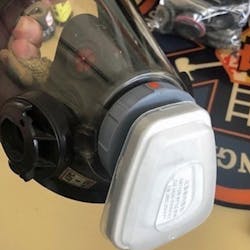MD Volunteer Firefighter Helps Design N95 Mask Adapter
Back in April, in the early stages of the coronavirus pandemic, there was a national shortage of protective N95 masks.
Ryan Githens and Joe Webster, both engineers for Oceaneering, a engineering and applied technologies company with offices in Hanover, used their design skills to create a workaround solution to keep first responders in their community safe — an adapter that allows firefighters to use their SCBA masks as an N95 filter, “protecting their respiratory system and face from potential exposure to the virus,” Githens said.
Githens, a senior electronic technician, is also volunteer firefighter with the Abingdon Fire Company. It’s as a volunteer firefighter that Githens and his colleagues rely on Self-Contained Breathing Apparatus, or SCBA, masks while on duty.
Githens’ work brought a fix for the scarce N95 mask issue. An N95 is a respirator which helps with airborne particle filtration, and offers better protection than a surgical mask against COVID-19.
“From the time of the conception of the idea, the actual time we put it in service was probably about three weeks,” Githens said. “We were waiting for certain parts to come in, but we had the actual adapter ready within about a week.”
When the fire company had trouble sourcing N95 masks, Githens found commercially available filter pads with equivalent N95 efficiency ratings. However, no product was available to connect the N95 filter cartridge directly to the SCBA face piece. A modification would be required to add the filter pad to the SCBA.
In need of design savvy and a 3D printer, Githens incorporated the help of Webster, a principal designer at Oceaneering. The two modeled the adapter piece using the SCBA face piece and the bayonet-style connection used for the N95 filter platform.
“Short of helping with simple design for some of the other systems we build, I’ve probably never had my hands this deep in a design as this,” Githens said.
Webster designed the adapter using SolidWorks, a computer-aided design and engineering modeling program. He worked through three iterations of the design before devising a functional model.
With Githens assistance in providing a SCBA mask and with a filter cartridge in hand, Webster printed a functional model of the adapter piece on his at-home 3D printer.
The initial design was modified to allow for increased airflow. A later modification to the design offered increased “grip area” at Githens’ request to make the adapter easier to install and remove.
“We produced 30 in total,” Githens said. “Right now about 18 are actually in service. The other 12 were from the first iteration.” All are at Abingdon Fire Company.
“When designing for 3D printing, one usually takes a minimalist approach — simply for the fact that 3D printing is a time-consuming process,” Webster said. “The first model that was delivered took 3½ hours to print each one. Changing the thickness of the grip area from ¼-inch to ?-inch thick increased the print time to 4½ hours each.”
The adaptation of the N95 filter pads allows Githens and others in the fire company to safely continue to perform their routine duties despite the mask shortage.
“The genesis of the part was, there was another local fire department that was using an adapter that went to the firefighter’s face mask, but that required another adapter they were having trouble getting for it to actually connect to the N95 filter,” Githens said. “So, the light bulb that kind of came on in my head was, why don’t I just combine these two parts and then we won’t have to worry about trying to find each adapter?”
The referred main adapter part was out of stock and there was no timeline for when it would be available again during the height of the pandemic.
The Abingdon Fire Company is considering using the adapter piece even after the COVID-19 crisis is over.
“It is being considered for overhaul use, we just haven’t gotten around to discussing that. Right now, it’s just all about the COVID, but it has been discussed to be used for other uses in the future,” Githens said.
If it is used, it can essentially work the way it is because of the N95 filter that’s in it.
“The filter pad itself will essentially be changed out after each use, so you would pull out the filter pad, clean, sanitize all the plastics with the adapter, put a new cotton filter pad in and it would be ready to go back in service,” Githens said.
While the adapters were designed as a solution to critical supply circumstances, Webster and Githens are considering filing a patent application for the design. For now, however, they feel rewarded in their “concept through completion” effort and are pleased to lend their time and design skills keeping local firefighters safe and ready to respond during a time of need.
The 3D printer file of the adapter has also been shared with other fire companies within Harford County, according to a news release from Oceaneering.
———
©2020 The Aegis (Bel Air, Md.)
Visit The Aegis (Bel Air, Md.) at www.baltimoresun.com/explore/harford/publications/the-aegis
Distributed by Tribune Content Agency, LLC.
